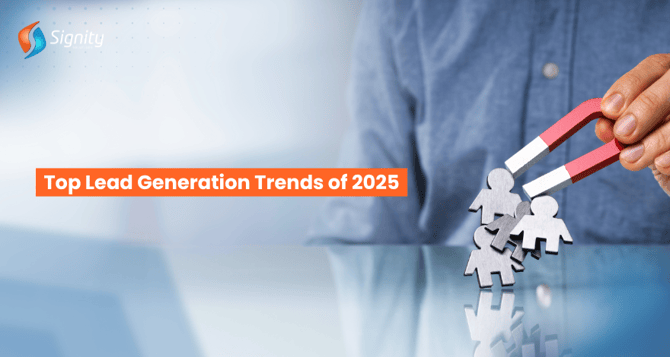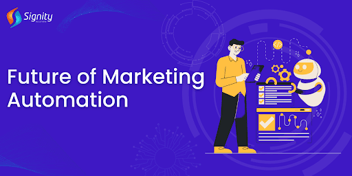Top Lead Generation Trends of 2025
Lead generation strategies are constantly evolving. As 2025 nears, businesses must embrace new trends to capture and convert leads effectively. This blog will walk you through the top lead-generation marketing trends to help your business thrive in the coming year.

With the digital marketing landscape changing, lead generation strategies are shifting in new and exciting directions.
Businesses need to keep up with the latest trends to stay competitive as we approach 2025.
In this blog, we'll discuss the top lead generation trends that will shape the future and how they can help you attract high-quality leads.
Key Takeaways
- Creating valuable, targeted content remains a strong method to engage audiences and generate leads.
- AI will transform business data analysis and enhance lead-generation strategies by offering deeper insights into customer behavior.
- In 2025, marketing will require hyper-personalization. This involves using real-time data to tailor messages and offers for individual prospects to boost conversion rates.
- As short videos, live streaming, and interactive content gain popularity, businesses must use more engaging formats to grab attention and convert potential customers.
- In 2025, using influencers and social media for marketing will be crucial for acquiring new customers and expanding your business.
Lead Generation Statistics: An Overview of Trends
- 50% of marketers consider lead generation a top priority in their marketing campaigns.
- 29% of marketers actively use content marketing.

Monthly Google searches for “social media marketing” are up 225% over the past 5 years.
- With 4.65 billion people using social media, marketers depend on social media more and more to find potential customers. Both B2B and B2C brands are very active on social media, and potential buyers like this trend.
- 85% of marketers believe that Generative AI will have a transformative impact on content creation.
- According to 74% of companies, content marketing has proven effective in boosting lead generation.
- 79% of B2B marketers consider emails as the most effective method for generating leads.
- 70% of B2B marketers believe that using video marketing to attract and convert prospects is effective.
Top Lead Generation Trends
After discussing the essential statistics, let’s shift our focus to the latest lead generation trends, such as marketing automation, intent-based marketing, and more. These trends are relevant for both business-to-business (B2B) and business-to-consumer (B2C) companies and can be leveraged to enhance your business efforts in 2025.
Email Lead Generation
Email is a classic marketing and communication strategy that is still very effective. Email marketing is a traditional channel that provides the highest return on investment. One in three marketers use email, and 87% plan to maintain or increase their investment. However, email marketers need to be prepared to adapt. A compelling way to enhance this strategy is to generate your own Bitly QR codes, which allow for easy tracking and customization of content shared with your audience.
To further enhance your email strategy and provide a modern touch, consider including Uniqode's digital business card in your email signature. This allows recipients to instantly access your contact information, social media links, and other relevant resources, increasing engagement and potential leads.
Analysts predict that the number of people using email will increase by 2.5% in 2025. This growth is expected to continue until the total number of email users worldwide reaches 4.73 billion.
Personalization is the best strategy to boost your email’s effectiveness.
In the coming year, email marketing teams can use the inbox to learn about and connect with customers through personalized experiences. To work more efficiently and create value, they can use integrations, collaboration, and tools powered by AI.
Marketing Automation
On average, 56% of companies are currently using Marketing automation. 40% of B2B companies are planning to adopt the technology.
Marketing Automation services help businesses efficiently manage and nurture leads through various channels, such as email campaigns and social media interactions, without needing constant manual effort. By automating repetitive tasks and processes, companies can focus on strategic growth while ensuring they don't miss out on any leads.

Automating lead nurturing can ensure timely follow-ups, keeping leads engaged through the buying journey by:
- Personalizing marketing campaigns that can be triggered automatically based on user behavior to make every interaction relevant to the lead's needs and preferences.
- Using automation tools to segment their audience and ensure targeted outreach resonates with specific groups of prospects.
Influencer Marketing
Influencer marketing has emerged as a powerful trend for lead generation. It has derived value on social media platforms by building trust and driving engagement.
Influencers are individuals or brands that have a large following and are perceived as an authority in their niche.
These influencers help businesses to tap into highly targeted audiences with more personalized content.
You can find influencers across every platform, like LinkedIn, Twitter, Instagram, YouTube, and more, using influencer marketing metrics to maximize cross-platform impact.
All you need to do is approach specific influencers who can create a relatable connection with the audience and improve conversion rates.
Businesses are having the most success with smaller, more specialized influencers. 47% of marketers find partnerships with micro-influencers effective, and they say it helps businesses reach engaged communities at a lower cost.
Additionally, if you are on a tight budget, you can find a lot of micro-influencers with 1,000 to 1,00,000 followers for effective engagement on all the platforms.
As social media algorithms shift more towards promoting genuine content and partnerships with specific niche influencers, businesses will be able to target their offerings to the right audiences.
53% of marketing teams that identified their marketing as “effective” invested in influencer marketing in 2023.
Looking ahead to 2025, you can expect this influencer marketing to be a core strategy for businesses looking to generate qualified leads.
Intent-based Lead Generation
Intent-based marketing has become a real trend in B2B strategies. It is not only about analyzing data but also decoding the genuine interest signals of potential clients.
|
Personalization Element |
Impact on Lead Generation |
|
Dynamic website content |
Increased engagement and time on-site |
|
Customized emails |
Higher open and click-through rates |
|
Personalized social ads |
Improved ad relevance and conversion rates |
|
Tailored recommendations |
Enhanced cross-selling & up-selling opportunities |
In 2025, intent-based marketing is poised to revolutionize lead-generation strategies. This approach shifts the focus from traditional demographics or general behaviors to understanding what users truly want. By doing so, marketers can deliver highly targeted and relevant content to potential customers, enhancing engagement and conversion rates.
Tools and platforms like ZoomInfo and ZoomInfo competitors are harnessing the power of intent data to help businesses identify and connect with high-intent prospects more effectively, making this strategy a game-changer for modern marketing.
Advanced Behavioral Analytics
Understanding how users behave is important. By looking at how users interact in different ways, marketers can learn a lot about:
- Search patterns
- Content consumption habits
- Purchase behaviors
- Engagement levels
This data-driven approach allows for more accurate prediction of user needs and preferences so they can plan their strategies better.
Real-time Content Personalization
With advanced analytics, real-time content personalization is possible. This approach includes:
- Dynamically adjusting website content
- Customizing email marketing campaigns
- Personalizing social media ads
- Tailoring product recommendations
By delivering the right message at the right time, marketers can significantly improve conversion rates and lead quality.
Predictive Intent Modeling
Using predictive intent modeling takes intent-based marketing to the next level. Marketers can leverage machine learning algorithms to:
- Anticipate user needs before they arise
- Identify potential pain points in the customer journey
- Predict future purchasing behaviors
- Optimize marketing campaigns in real-time
This proactive approach allows businesses to stay one step ahead of their competitors and provide unparalleled value to their leads.
Want High-Quality Leads?
Get Insight into Emerging Lead Generation Trends to Boost Your Lead Quality and Drive Your Business Forward.
Businesses can quickly leverage the benefits of an intent-based approach by following the below steps:
1. Determine the Genuine Interest
Analyze closely how your prospects interact with your content. If they show consistent engagement, this shows something beyond a casual interest.
2. Focus on Engaged Prospects
Once you have identified the engaged prospects, move towards a more personalized engagement. Adapt the messaging to align with the specific pain points of the prospect and move the conversation forward.
3. Resource Allocation
Allocate your marketing resources to prospects who are showing high engagement. This ensures that you are investing in an area that is most likely to bring positive outcomes.
4. Continuous Feedback
Use feedback and insights to ensure continuous feedback for higher engagement.
Account-based Marketing
Account-based marketing is a great way to generate leads.
 Instead of focusing on individual leads, ABM helps businesses engage and convert their target customers by concentrating on marketing and sales efforts on specific accounts.
Instead of focusing on individual leads, ABM helps businesses engage and convert their target customers by concentrating on marketing and sales efforts on specific accounts.
87% of marketers have reported better returns from ABM compared to other marketing strategies. This shift toward account-centric marketing is clearly producing tangible results.
Personalized Outreach
By using intent data and predictive analytics, Account-Based Marketing (ABM) helps businesses find accounts that are most likely to make a purchase. Then, companies can customize their outreach to each target account based on their interests and challenges. This makes the messages more effective and helps move the accounts further along the sales process.
For instance, marketing teams can create personalized landing pages, emails, and ads for each account that directly address their specific problems. As ABM grows, automation tools can assist in delivering this personalized messaging without requiring a lot of manual work.
Aligning Sales and Marketing Efforts
ABM offers a big advantage by helping sales and marketing work better together. When they share information about the companies they're trying to sell to, the sales team can follow up on leads that came from marketing. This collaboration, based on data, is what makes ABM so good at lead conversion.
Content Marketing
Around 3 in 4 content marketers use content to generate leads. Today's marketers understand that content is one of the most effective methods for generating inbound leads, especially in B2B marketing. 85% of B2B marketers use content to generate leads, compared to just 60% of B2C marketers. On average, 76% of content marketers use content to generate leads.
By creating high-quality, useful content for specific groups of people, businesses can attract and engage potential leads at different stages of the buying process. Content like blog posts, eBooks, videos, and infographics that educate, inform, or entertain is crucial for building trust and turning prospects into qualified leads.
Content Personalization
Creating content that is highly relevant to your audience by using customer data to speak directly to different segments of your audience.
Video Content
Short videos and live streaming will keep being popular. They are a dynamic way to engage potential customers, as shown in the graph above, which is on top.
According to Think With Google, over 60% of people prefer watching videos over reading lengthy articles.
Therefore, to create a desirable impact, you can create some engaging videos using a reliable online video editor or get help from any paid video editor tool. This can help you engage your users like never before.
SEO Optimization
Creating content that performs well on search engines and meets user needs will continue to be important for attracting natural traffic and generating leads.
Navigate Google’s New Updates
Every time Google releases its latest algorithm updates, it demands a fresh approach to marketing. Since Google mainly deals with content, a new approach is required. Here are a few things that can help you navigate these updates successfully.
1. Create Impactful Content
If your website quickly returns to Google search results, consider it a red flag. This suggests that your website content does not meet the bar that may engage the visitor.
It is essential to create expert-driven and engaging content that captures and holds the target audience's attention. This may also include removing content that is not performing well to focus on quality rather than quantity.
2. Enhance Review Quality
The recent reviews update from Google in 2023 is about how Google reshaped the way we approach reviews. To make your reviews stand out, you must consider the following:
- Showcase your subject matter expertise that can be helpful to them.
- Empathize the readers by providing the relevant information that they are searching for.
- Provide unique points and quantifiable insights about the service offerings.
- Support the reviews with evidence like video, audio, or even links rather than just textual testimonials.
- Provide a balanced view of mentioning both pros and cons.
3. Optimize AI-driven Content
Since AI tools have been a transforming force within the content fields, their repetitive tendency can be an issue. Additionally, the pattern of creating lengthy sentences depicting the same thing repetitively can also develop problems.
To address this, you must transform the content with the human intent. For instance, your writer is getting help from AI tools and creating human-intent content for the audience.
However, the content portion that took the help of AI tools might not drive the same value. So, the writer must review the content to deliver the same value, or an AI development company can help you optimize it all efficiently. If the content portion as it is doesn’t help, you can also use AI video generator tools to capture the audience’s attention, as video format can also navigate the complexities of AI-driven content.
Chatbots
Chatbots are becoming more popular as more businesses are considering using them to provide 24-hour support. Most consumers are open to chatbots and believe they improve their experience because they provide faster responses and are highly accurate.
Hyper-Personalization and Data-Driven Strategies
Implementing hyper-personalization and data-driven strategies allows businesses to strengthen their ability to convert more leads, retain customers, and deliver better overall customer experiences in 2025.
Personalized interactions help build trust and make deals move forward more efficiently. Businesses that use personalization report up to a 20% improvement in sales performance.
Hyper-personalization uses real-time data, AI, and machine learning to deliver highly tailored experiences based on individual user behavior and preferences. This helps businesses improve engagement and lead quality.
Personalization, according to McKinsey, can significantly reduce customer acquisition costs, increase revenues, and improve marketing ROI for companies. The potential benefits include a 50% reduction in customer acquisition costs, a 5-15% lift in revenues, and a 10-30% increase in marketing ROI. These improvements are tangible and significant for companies.
Gone are the days of one-size-fits-all marketing. Using data to understand customers will be crucial for creating personalized marketing campaigns that meet the specific needs of potential customers at every interaction.
Voice Search and Conversational Marketing
Integrating AI-powered chatbots into your lead generation strategies can help you engage with potential leads in real-time, answer their questions, provide information, and even assist in the initial stages of the sales process.
Omnichannel Marketing
One important trend in finding new business customers is using multiple ways to reach them. People are always using different types of media, like search engines, social media, email, and streaming services.
This is true for business customers, too. To find the best customers, you need to use all these different ways to reach them. You have to think about where your customers are and then put your messages there.
For instance, you can opt for some third-party platforms to perform link building to enhance your target approach. The sole purpose of link building is to link out to other websites that are willing to share links with the relevant content. This will help drive traffic to your site & position you as a thought leader.
Generative AI
Generative AI tools can help businesses create various content, such as email marketing campaigns and blog posts. This is especially useful for lead generation by creating content that attracts and nurtures leads.
For example, if you need help writing an article, you can use tools like ChatGPT to develop an outline. As these tools become more advanced, companies can use them in their strategies to maximize lead generation while reducing workload and delivering improved customer experiences using Gen AI.
Bottom Line
In 2025, lead generation will be shaped by advanced technologies and changing consumer expectations. To stay competitive, businesses will use top lead generation trends like data-driven strategies, personalized approaches, and AI and automation to reach their audience.
Struggling with Low Conversion Rates?
Explore Strategies That Bring in Leads Who Are Ready to Buy and Turn Leads Into Loyal Customers!
AI tools will enhance marketers' ability to predict customer behavior and improve conversion rates through better personalization. Video and social media will continue to engage audiences, while automation will help businesses reach more people without sacrificing personal connections.
Businesses that are flexible, open to embracing these changes, and dedicated to providing value through personalized, data-based experiences will be at the forefront of attracting and nurturing high-quality leads in 2025.



.png?width=344&height=101&name=Mask%20group%20(5).png)















